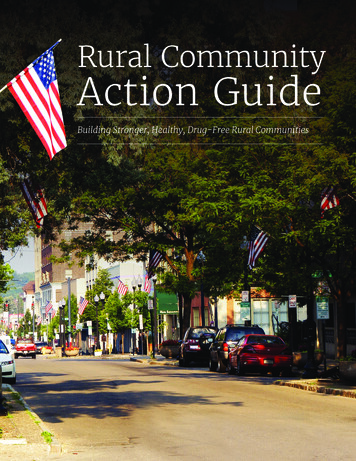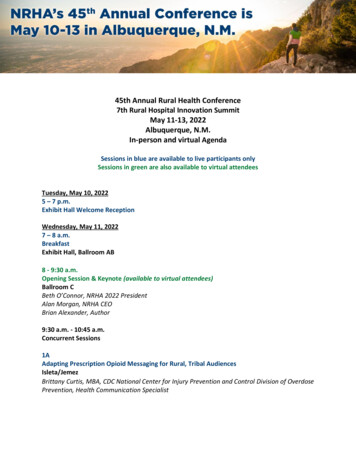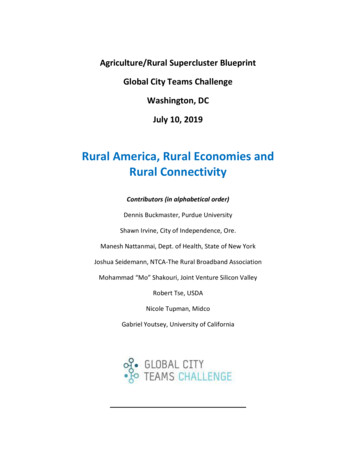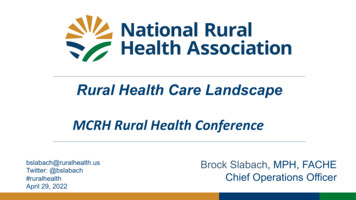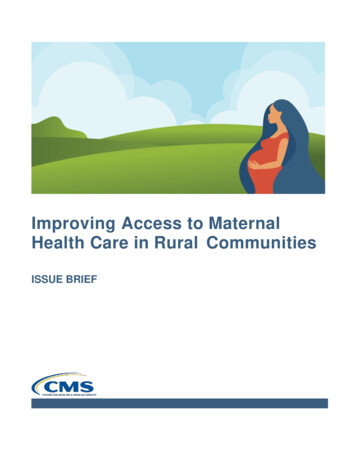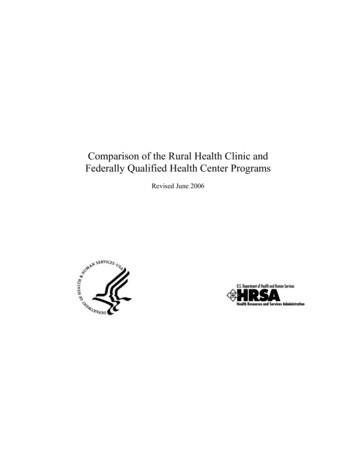
Transcription
Comparison of the Rural Health Clinic andFederally Qualified Health Center ProgramsRevised June 2006
Preparation of this report was supported by the U.S. Department of Health and HumanServices, Health Resources and Services Administration, Office of Rural Health Policy.Copies may be obtained, while supplies last, from:HRSA Information Center22815 Glenn Dr. #103Sterling, VA 20164(703) 902-1325This document may be reproduced.
PrefaceWe are pleased to share with you this comparative description of the Rural Health Clinic(RHC) and the Federally Qualified Health Center (FQHC) programs. This version hasbeen updated to reflect changes and clarifications since the document was last updated in1995.Both programs offer very real opportunities for enhancing access to health care inunderserved rural areas. The following information provides a basic description of theprograms, including some complexities and unique aspects of each.The Health Resources and Services Administration (HRSA) has prepared this documentto help health care practitioners understand the differences in the programs and thebenefits that each offers in their decisions. We trust you will find it useful.Dr. Elizabeth Duke, PhD.AdministratorHRSA, DHHS
Table of ContentsChapter NumberTopicPageIntroduction4Chapter 1Legislative Background6Chapter 2Cost Based Reimbursement Advantages andDisadvantages8Chapter 3Overview of RHC and FQHC Programs10Chapter 4Waivers20Chapter 5Covered Scope of Services21Chapter 6Reimbursement25Chapter 7Analysis of the Financial Effect for anIndependent RHC/FQHC30Chapter 8The Provider Based Rural Health Clinic36Chapter 9Other Issues42Conclusion44Appendix AAcronyms45Appendix BAdditional Resources463
IntroductionThe primary intent of this document is to provide a general comparison of the financialcomponents of the Rural Health Clinic (RHC) and Federally Qualified Health Center(FQHC) programs under Medicare and Medicaid. While the document also providessome discussion of the programmatic comparisons between RHCs and FQHCs, a fullreview of the separate programmatic and regulatory requirements for RHCs and FQHCsthat receive funding under Section 330 of the Public Health Service Act is beyond thescope of this paper. With the growth in the number of practices converting to RHC orFQHC status, and growing interest in the development of networks, health careorganizations in underserved areas are presented with an opportunity to improve revenuesand expand their services, as well as the challenge of deciding which opportunity can bestmeet their goals. Some of the organizations and individuals likely to be interested in theseprograms include: Private practices considering conversion from fee for service to costbased reimbursement Critical Access Hospitals (CAHs) Current RHCs considering conversion to FQHC status Migrant health programs Health care for the homeless programs Health care for public housing programs Tribal health care programs Free Clinics Hospitals and state health planners seeking methods to support primarycare in underserved areas Providers such as physicians, physician assistants (PAs), nursepractitioners (NPs), certified nurse midwives (CNMs) and others Boards of directors, administrators, and fiscal personnel involved instrategic planning for their organizationsIn order to present these programs as thoroughly as possible, this document includes abrief history of both the RHC and FQHC programs, an overview of the theory of costbased reimbursement, and a description of the differences in eligibility criteria,programmatic requirements, and covered services. Finally, there is a description of thepossible financial effect of cost-based reimbursement. This description is very basic anduseful only for demonstration purposes. A thorough analysis needs to be performed when4
considering a change in reimbursement methods.This document does not attempt to describe every aspect of each program. Rather, itfocuses on those aspects where there are differences between an RHC and an FQHC.There are several issues, particularly in the areas of Medicare benefits and cost findingprinciples, which are common to both programs, and therefore, not described.In 2000, Congress changed the way both RHCs and FQHCs are reimbursed underMedicaid. The cost-based reimbursement system was replaced by a Prospective PaymentSystem (PPS) developed exclusively for RHCs and FQHCs. In addition, States weregiven greater flexibility to create new payment mechanisms for RHCs and FQHCs. Inconsidering either the FQHC or RHC option, you are strongly encouraged to contact yourState Medicaid office to determine the specific policies that have been put in place forRHCs or FQHCs in your State.In 2002, Congress created a new “facility” shortage designation for both RHCs andFQHCs. Under this new authority, individual RHCs and FQHCs can be designated ashealth professional shortage area (HPSA) facilities thereby permitting participation in theNational Health Services Corps program, as well as other programs that utilize the HPSAdesignation as a criterion for eligibility.Both the RHC and FQHC programs offer tremendous opportunities to communities orentities interested in pursuing either of these options. It is important, however, to pursueRHC or FQHC designation for the right reasons. The intent of these programs is to helpmake health care available in communities or to individuals where it might be difficult orimpossible utilizing traditional fee-for-service or capitated payment methodologies.It is important to keep in mind that while Medicare or Medicaid payments for servicesmay be better in the aggregate than under other payment formulas, these paymentmethodologies are simply intended to cover the clinic’s or center’s reasonable costs.5
Chapter 1Legislative BackgroundBackground Description of the Rural Health Clinic ProgramThe Rural Health Clinics Act (P.L. 95-210) was passed by Congress and signed into lawby President Carter in 1977. The goal of this Act was twofold. First, it encouraged theutilization of PAs and NPs by providing reimbursement for services these healthprofessionals provided to Medicare and Medicaid patients, even in the absence of a fulltime physician. Second, it created a cost-based reimbursement mechanism for serviceswhen provided at clinics located in underserved rural areas.Because of subsequent changes in the Medicare law authorizing Medicare Part Bcoverage for PAs and NPs in all practice settings, not just RHCs, the original incentivefor utilizing PAs and NPs was diminished. However, because an RHC gets reimbursedthe same amount from Medicare and Medicaid regardless of whether the patient is seenby a mid-level provider (MLP) such as a PA, NP, CMN, or physician, the facilitycontinues to have a strong incentive to utilize these practitioners whenever it is clinicallyappropriate.P.L. 95-210 specified that regulations implementing the RHC Act define a set of RHCservices, often referred to as “core” services. These services, detailed in the coveredscope of services chapter of this document, are to be reimbursed by Medicare on the basisof an All Inclusive Reimbursement Rate (AIRR) reflecting the cost of the services.Furthermore, these services must be included in each State’s Medicaid plan as requiredMedicaid services.The Benefits Improvement and Protection Act of 2000 (BIPA) dramatically changed theway State Medicaid programs must reimburse RHCs. In lieu of cost-basedreimbursement, Medicaid now pays RHCs using a PPS methodology. This PPSmethodology varies by State and the payment rate may be clinic specific.Background Description of the FQHC ProgramThe term “Federally Qualified Health Center,” or FQHC, refers to three different types ofclinics: Health Centers (HCs) funded under Section 330 of the Public Health Service(PHS) Act, including Community Health Centers (CHCs), Migrant HealthCenters (MHCs), Health Care for the Homeless Health Centers (HCHs), andPublic Housing Primary Care Centers (PHPCs); (Note: Information regardingHCHs and PHPCs is not included in this publication. Further informationregarding these programs may be found at http://www.bphc.hrsa.gov) FQHC “Look-Alikes,” or FQHCLAs, that have been identified by HRSA andcertified by CMS as meeting the definition of “Health Center” under Section 3306
of the PHS Act, although they do not receive grant funding under Section 330;andOutpatient health programs/facilities operated by tribal organizations (under theIndian Self-Determination Act) or urban Indian organizations (under the IndianHealth Care Improvement Act).The FQHC program [enacted under the Omnibus Budget Reconciliation Act of 1989(ORBA 89) and expanded under the Omnibus Budget Reconciliation Act of 1990 (OBRA90)] provides for cost-based reimbursement under Medicare and Medicaid forlegislatively specified services.The FQHC program was a logical extension of the Community/Migrant Health Center(CHC/MHC) programs enacted in the 1960s and 1970s. The original CHC/MHCprograms provided Federal grants to Community Health Centers (CHCs) or MigrantHealth Centers (MHCs) for the care of uninsured individuals. These facilities receivedno special Medicare or Medicaid payments.Congress created the FQHC program to allow special Medicare and Medicaid paymentsfor CHCs and MHCs thereby ensuring that grant dollars intended for the uninsured wereavailable for that purpose. In order to extend the CHC/MHC concept, Congress alsoauthorized the special Medicare and Medicaid payments for clinics that operate incompliance with the requirements of the FQHC program, but that do not receive grantfunding under Section 330 of the PHS Act. These clinics are commonly known as“Look-Alikes”.All FQHCs receive cost-based reimbursement from Medicare based upon the samepayment principles as RHCs. As was mentioned above with respect to the RHC program,the Benefits Improvement and Protection Act of 2000 (BIPA) dramatically changed theway State Medicaid programs must reimburse FQHCs. In lieu of a retroactive cost-basedreimbursement, Medicaid now pays RHCs using a PPS methodology based on thehistorical reasonable costs of the center. This PPS methodology varies by State and thepayment rate may be clinic specific.7
Chapter 2Cost Based ReimbursementAdvantages and DisadvantagesTheoryIn a fee-for-service practice, revenue is estimated on the basis of procedures, such asoffice visits, lab tests and x-rays. The practice anticipates the number of procedures theywill perform and the revenue associated with each of these procedures.In an RHC/FQHC, revenue is estimated on an average cost per visit (up to a cap, ifapplicable) for each Medicare visit. If, for example, an all inclusive reimbursement rateof 60.00 is established, that rate is the reimbursement received for each face-to-faceencounter by the practice, regardless of the number or type of procedures provided duringa visit, as shown below.ProcedurePatient #1:Office VisitFee-for-ServicePayment 39.00Cost ReimbursementPayment(Clinic’s AIRR) 60.00 39.00 60.00 35.0015.0050.00----------- 100.00 60.0015.000------------- 75.00TotalPatient #2: History and PhysicalLab TestsSet & Cast FractureTotalMedicare will reimburse the practice 80 percent of the All Inclusive Reimbursement Rate(AIRR) and the patient will be responsible for 20 percent of the usual and customarycharge. In order to project revenue, clinic/center managers need to determine totalpayments from Medicare fee-for-service (Part B) and the total number of Medicare visits.These figures would then be used to determine the clinic’s average payment per visitfrom Medicare Part B, which could then be compared with the AIRR the clinic/centerprojected if it converted to RHC or FQHC status.The change from analyzing payments on a fee-for-service (procedure) basis to an averagevisit basis will require education for managers, staff, and boards. As the example aboveillustrates, you should not look at one individual patient. The concept of RHC/FQHCcost-based reimbursement is that over the course of a year, your revenues will be closerto your actual costs. However payments for individual patient encounters could be higheror lower than traditional Medicare. Each clinic’s experience may be different. It isessential that you calculate your estimates using a year’s worth of information rather thana window of time that may or may not represent the annual costs of operating the facility.8
Financial Disadvantages of Cost ReimbursementA practice that, under a fee-for-service reimbursement method, offers a large number ofhigh charge/high cost procedures (such as surgery) may find that its current averagepayment per visit is higher than the example used earlier. In this instance, the advantageof cost reimbursement will be less. The RHC/FQHC payment systems are geared toprimary care services typically performed in a physician’s office. Cost reimbursement ina high tech specialty practice may have a negligible, or even negative, effect on practicerevenue.A general rule of thumb for this type of procedure oriented practice is that, if the averagepayment for Medicare visits is close to the average payment for all other payer typescombined, or the AIRR cap, it is likely that cost-based reimbursement will not provide anappreciable increase in patient revenue.A Note of CautionAlthough not a disadvantage, a practice receiving cost-based reimbursement needs toclosely monitor costs throughout the year. A practice converting to RHC or FQHC statuswill be required to submit a budget reflecting assumptions regarding costs and visits.This information will be reviewed for reasonableness by the Medicare fiscal intermediaryand then used to calculate the reimbursement rate for the upcoming fiscal year. It isimperative that such a budget reflect reality as closely as possible in order to make certainthat cash flow is adequate, on one hand, and that large liabilities are not being accrued, onthe other. The RHC and FQHC programs conduct a year end reconciliation of costreimbursement, referred to as the cost settlement. If the AIRR is too low and does notreflect reasonable costs during the year, the practice will receive a year end payment. Thepractice also will likely experience cash flow difficulties. If the rate, based on budgetprojections, is too high, the practice can end the year having to pay back Medicare. Notonly must original rate estimates be as accurate as possible, the rate must be monitoredperiodically to ensure it is still appropriate. A practice should establish accountingprocedures that can accrue ongoing cost reimbursement adjustments based on projectedcost reimbursement rates.9
Chapter 3Overview of RHC and FQHC ProgramsComparison of Basic Eligibility CriteriaCriteriaLocationShortage AreaCorporate StructureBoard of DirectorsClinical StaffingRural Health ClinicNon-urbanized AreaMUA, HPSA or GovernorDesignated Shortage AreaUnincorporated, public,nonprofit or for profitN/AMLP required at least 50% ofthe time the clinic is openFederally Qualified Health CenterN/AMUA or MUPTax-exempt nonprofit or public.RequiredNo specific requirements.LocationAn RHC must be located in an area defined by the U.S. Department of Commerce,Census Bureau as non-urbanized. The Census Bureau definition of a non-urbanized areais an area that is outside of an urbanized area. An urbanized area is defined as, “Adensely settled territory that contains 50,000 or more people.”Additional information regarding the definition of urbanized area that is used for locationdeterminations under the RHC program can be found at http://www.census.gov; however,the final determination regarding location eligibility is made by the Centers for Medicareand Medicaid Services (CMS) Regional Offices.The FQHC program bases the distinction between urban and rural on whether or not thearea in which a clinic is located is part of a Metropolitan Statistical Area (MSA). AnFQHC may be located in either an urban or rural area. A rural area is one which isoutside of an MSA. The importance of whether a clinic is designated urban or rural isdue to the difference in payment caps that exist for rural versus urban FQHCs.Shortage Area DesignationBoth the RHC and FQHC programs require a shortage area designation, also known as adesignation of underservice. A practice is eligible for initial RHC certification if it islocated in an area “currently” designated as a Medically Underserved Area (MUA) orHealth Professional Shortage Area (HPSA) - either by population or geographic area orlocation. In addition, governors are allowed to designate areas with a shortage ofpersonal health services through the use of statewide shortage designation plans approvedby HRSA’s Bureau of Health Professions (BHPr). In order for a shortage areadesignation to be considered “current” it cannot be more than 3 years old. Therefore, ifyou are pursuing initial RHC designation in 2006, the shortage area designation musthave been reviewed and approved within the previous 3 years (2003, 2004, and 2005). Ifthe designation is more than 3 years old, the application for RHC status cannot beprocessed.10
An FQHC must be located, as appropriate, to make services accessible to the residents ofa designated MUA or Medically Underserved Population (MUP). Location in a HPSA orgovernor designated shortage area does not meet the shortage area requirement for theFQHC program. Look-Alikes may serve a whole or partial MUA/MUP so long as itdemonstrates that it serves the neediest population in the service area or addresses gaps inservices and/or health disparities.A practice should verify the shortage area designation with State officials. Completeinformation regarding currently designated areas and eligibility criteria is available fromBHPr at http://www.bhpr.hrsa.gov or by contacting:U.S. Department of Health and Human ServicesHealth Resources and Services AdministrationBureau of Health ProfessionsDivision of Shortage Designation5600 Fishers LaneParklawn Building, Room 8C-26Rockville, MD 20857The Health Care Safety Net Amendments of 2002 authorized a new HPSA facilitydesignation for both RHCs and FQHCs. Facility HPSA status allows a clinic toparticipate in the National Health Service Corps program; however, the facility HPSAdesignation does not meet the shortage areas requirements for either the RHC or FQHCprogram.In order for RHCs and FQHCs to be eligible for a HPSA facility designation, the clinic orcenter must agree to certain principles. The entity shall: Not deny requested health care services, and shall not discriminate in theprovision of services, to an individual who is unable to pay for services or whoseservices are paid by the Medicare, Medicaid, or State Children’s Health InsuranceProgram (SCHIP);Prepare a schedule of fees consistent with locally prevailing rates or charges;Prepare a corresponding schedule of discounts (including waivers) to be applied tosuch fees or payments, with adjustments made on the basis of the patient’s abilityto pay;Make every reasonable effort to secure from patients the fees and payments forservices, and fees should be sufficiently discounted in accordance with theestablished schedule of discounts;Accept assignment for Medicare beneficiaries and shall enter into agreements withagencies administering Medicaid and SCHIP, to ensure coverage of beneficiariesof these programs; andTake reasonable and appropriate steps to collect all payments due for services.This is a voluntary program. If the RHC or FQHC agrees to the above requirements, theclinic or center will receive a HPSA facility designation for 6 years. Look-Alikes receivethe HPSA facility designation automatically once they are certified by CMS.11
Corporate StructureNonprofit and for profit corporations, public agencies, sole proprietorships, andpartnerships are eligible for RHC status.FQHC status is limited to nonprofit, tax exempt corporations and public agencies.HRSA’s Bureau of Primary Health Care (BPHC) defines tax exempt as 501(c)(3) status.Look-Alikes cannot be owned, controlled or operated by another entity.Board of DirectorsThe RHC program does not have any requirements related to boards of directors.FQHC status is restricted to nonprofit corporations and public agencies. Therefore, aboard of directors that meets specific criteria, as described in the governance section ofthis chapter, is required.Clinical Staffing RequirementsAn RHC is required to employ a mid-level provider (MLP) at least 50 percent of the timethe practice is open to see patients.FQHCs do not have specific requirements related to MLP staffing, although they arepermitted to use MLP staffing as a component of their clinic staffing where appropriate.12
Required Scope of ServicesComparison of Required Scope of ServicesCriteriaRural Health ClinicPrimary Health Care ServicesRequiredPrimary Care for All Life-cycleAgesBasic LabNot RequiredPharmacySix specified tests required onsite, others required on-site orunder arrangementFirst response capabilitiesrequiredRequired on-site or underarrangementNot RequiredPreventive HealthNot RequiredPreventive DentalNot RequiredTransportationNot RequiredCase ManagementNot RequiredDental Screening for ChildrenNot RequiredEmergency CareFederally Qualified HealthCenterRequiredRequired on-site or underarrangementRequired on-site or underarrangementAfter Hours CareNot RequiredRequired on-site or underarrangementRequired on-site or underarrangementRequired on-site or underarrangementRequired on-site or underarrangementRequired on-site or underarrangementRequired by the site or underarrangementRequired on site or underarrangementRequired on site or underarrangementRequiredHospital/Specialty CareRequired by clinic staff or underarrangementRequired by clinic staff or underarrangementRadiological ServicesPrimary Health ServicesThe provision of primary health care is required in both programs. Primary health careservices for the purposes of these programs are defined as the treatment of acute orchronic medical problems which usually bring a patient to a physician’s office.Primary Care for All LifecyclesAn RHC may be any primary care practice, (e.g. family practice, pediatric,obstetric/gynecology, or internal medicine). An RHC can include specialty services, aslong as the RHC can document that it is primarily in the business of delivering primarycare services.An FQHC must provide primary care for all life-cycle ages. Therefore, primary carespecialty practices (such as pediatrics or geriatrics) are not eligible for FQHC status,unless they provide for primary care for all life-cycles through contract or formal referralarrangements with accountability to the FQHC.13
Basic Lab ServicesAn RHC is required to provide the following minimum lab services on site: Chemical examination of urine by stick or tabletHemoglobin or hematocritBlood sugarExamination of stool specimens for occult bloodPregnancy testsPrimary cultures for transmittal to a certified labIf the RHC performs only these six tests, it may obtain a waiver certificate from theregional Clinical Laboratory Improvement Act (CLIA) office. If an RHC provides othertests on site, it will have to comply with CLIA requirements for the lab services actuallydelivered.There are no specific requirements for lab services that must be provided on site forFQHCs. Both programs require that complete lab services be available througharrangements.Emergency Care ServicesRHCs are required to provide medical emergency procedures as a first response tocommon life threatening injuries and acute illnesses. The definition of first response isthat service commonly provided in a physician office.FQHCs are required to provide emergency care either on site or through clearly definedarrangements for access to health care for medical emergencies during and after theFQHC’s regularly scheduled hours. FQHCs must provide for access to emergency care24/7.Radiological ServicesBoth FQHCs and RHCs are required to provide radiological services on site or througharrangements with other providers.Pharmacy ServicesRHCs are not required to provide pharmacy services, but are not prohibited fromproviding these services on site.FQHCs are required to ensure access to pharmacy services, either on site or througharrangements with other providers.14
Preventive Health ServicesThere are no requirements for the provision of preventive health services for RHCs.FQHCs are required to provide preventive health services on site or througharrangements with other providers. Preventive health services include medical socialservices, nutritional assessment and referral, preventive health education, children's eyeand ear examinations, perinatal services, well child services (including periodicscreening), immunizations, and voluntary family planning services.Preventive Dental ServicesThere are no requirements for the provision of preventive dental services for RHCs.FQHCs are required to provide preventive dental services on site or througharrangements with other providers. Preventive dental services are defined as briefexaminations of the teeth and gums with referral to a dentist for prophylaxis andtreatment.Transportation ServicesThere are no requirements for the provision of transportation services for RHCs.FQHCs are required to provide transportation services, as necessary for adequate patientcare, either directly or through arrangements with other transportation service providers.Case Management ServicesThere are no requirements for the provision of case management services for RHCs.FQHCs are required to provide case management services on site or througharrangements with other case management agencies. FQHCs are also required to provideoutreach and translation enabling services.After Hours CoverageThere are no specific requirements for an RHC to directly provide on call coverage,although the RHC must make arrangements for access to care, i.e. referral to a hospitaloutpatient department.An FQHC should provide professional coverage when the practice is closed, directly orthrough an after hours care system.Hospital/Specialty CareBoth RHCs and FQHCs must either provide or have arrangements with other health care15
providers to furnish inpatient hospital services and specialty care.The RHC program has no requirements for hospital admitting privileges, but a practicemust demonstrate that hospital services are available to patients. FQHCs are required tohave admitting privileges for physicians in the practice or must document a hospitalcoverage plan that ensures continuity of care.16
Management and FinanceComparison of Management CriteriaCriteriaCompliance with Civil Rights ActRequired annual evaluation ofclinic operationsRequiredFederally Qualified HealthCenterRequired annual evaluation ofclinic utilizationAssurance requiredWritten Policies and ProceduresRequiredRequiredEvaluationRural Health ClinicSliding Fee ScaleNot RequiredRequiredInitial ApplicationApplication forms and on-sitesurveyRecertificationOn-site surveyManagement and Control SystemsIndependent Financial AuditMust demonstrate ability tomanage cost-basedreimbursementNot RequiredApplication narrative and on-sitesurvey (on-site survey is notmandatory for FQHCs or lookalikes at the time of application)Statement of compliance withprogram requirementsMust provide written descriptionof systemsGovernanceNo specific requirementsRequiredUser-majority board of directorsrequiredEvaluation of Need and Community ImpactRHCs and FQHCs are required to perform an annual evaluation of the total program,including an analysis of the utilization of services and, at least, the number of patientsserved and volume of services.In addition, FQHCs must prepare documentation describing the physical boundaries ofthe area served, the demographics and health needs of the population, available healthresources, and the rate of poverty in the area. They must demonstrate a need for servicesin the community. FQHCs must also demonstrate that the practice is serving those mostin need, including low income, uninsured, minorities, pregnant women, elderly, and,where appropriate, migrant or seasonal farm workers and those with special needs.FQHCs must further describe the patient population using its services in numbers ofpatients and visits (encounters) during the last 12 months by age, sex, race, insurancestatus, income, and those with special needs.Compliance with the Civil Rights Act (CRA)RHCs are required to comply with the CRA in order to participate in Medicaid. If RHCstatus is chosen only for Medicare, compliance with the CRA is not required.FQHCs are required to provide assurances that they are in compliance with civil rightslegislation.17
Written Policies and ProceduresBoth RHCs and FQHCs are required to document policies and procedures.Sliding Fee Scale Discount Based Upon Ability to PayRHCs are permitted, but not required, to provide sliding fee reductions to collections.Should an RHC opt to obtain the facility HPSA designation, it would be required to havea sliding fee scale.FQHCs must utilize a sliding fee scale with varying discounts available based on patientfamily size and income in accordance with Federal poverty guidelines.Initial Certification/DesignationAn RHC completes application forms and participates in an extensive onsite survey.An FQHC submits a narrative application describing need and community impact and themethods by which it complies with HRSA program expectations. There is no requirementfor an onsite survey. However, HRSA may conduct an onsite survey to confirmcompliance with assurances in the application.CMS will not always survey an FQHC prior to approving agreements for participation inMedicare and Medicaid. However, CMS is responsible for resolving complaints aboutFQHC compliance with Medicare and Medicaid rules and for determining whetherFQHCs meet applicable standards for participation in Medicare and Medicaid aftersig
The FQHC program [enacted under the Omnibus Budget Reconciliation Act of 1989 (ORBA 89) and expanded under the Omnibus Budget Reconciliation Act of 1990 (OBRA 90)] provides for cost-based reimbursement under Medicare and Medicaid for legislatively specified services. The FQHC program was a logical extension of the Community/Migrant Health Center



